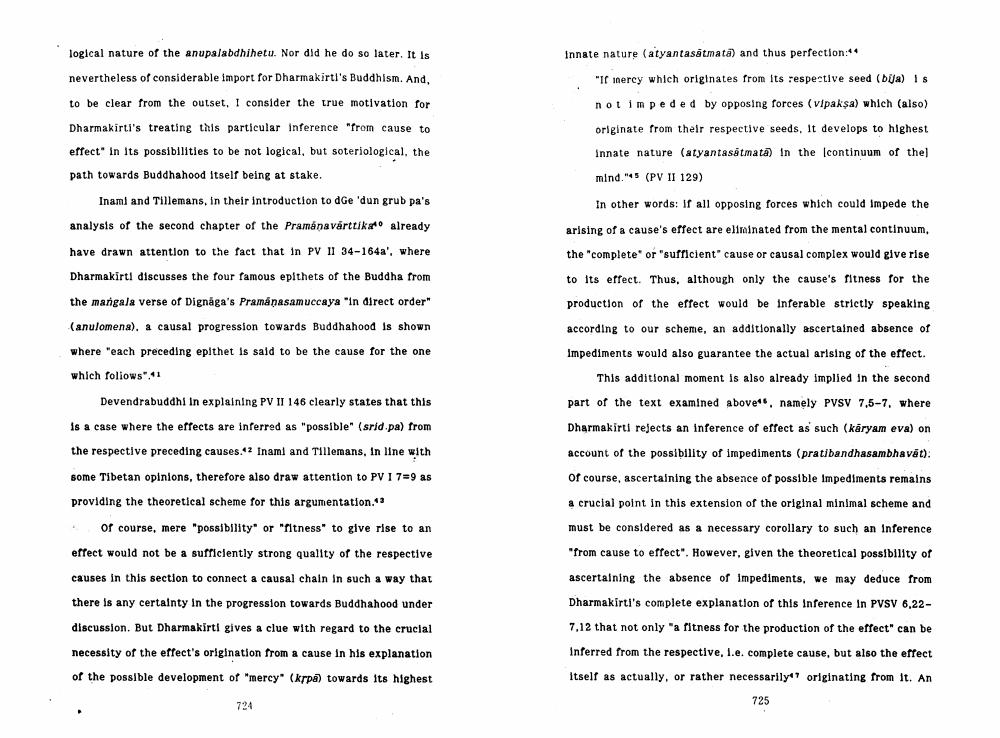Book Title: Dharmakirti On Inference Of Effect Author(s): Ernat Steinkellner Publisher: Ernat Steinkellner View full book textPage 8
________________ logical nature of the anupalabdhihetu. Nor did he do so later. It is nevertheless of considerable import for Dharmakirti's Buddhism. And, to be clear from the outset, I consider the true motivation for Innate nature (atyantasatmată) and thus perfection:** "It inerey which originates from its respective seed (bua) is not impeded by opposing forces (vipaksa) which (also) originate from their respective seeds. It develops to highest innate nature (atyantasåtmata) in the continuum of the] Dharmakirti's treating this particular inference from cause to effect" in its possibilities to be not logical, but soteriological, the path towards Buddhahood itself being at stake. mind. 45 (PV II 129) Inami and Tillemans, in their introduction to dGe 'dun grub pa's In other words: If all opposing forces which could impede the arising of a cause's effect are eliminated from the mental continuum, analysis of the second chapter of the Pramanavárttika already have drawn attention to the fact that in PV 11 34-164a', where Dharmakirti discusses the four famous epithets of the Buddha from the "complete" or "sufficient cause or causal complex would give rise to its effect. Thus, although only the cause's fitness for the production of the effect would be inferable strictly speaking the mangala verse of Dignaga's Pramánasamuccaya "in direct order" (anulomena), a causal progression towards Buddhahood is shown according to our scheme, an additionally ascertained absence of where "each preceding epithet is said to be the cause for the one Impediments would also guarantee the actual arising of the effect. which foliows":41 Devendrabuddhi in explaining PV II 146 clearly states that this This additional moment is also already implied in the second part of the text examined above, namely PVSV 7,5-7, where Dharmakirti rejects an inference of effect as such (karyam eva) on is a case where the effects are inferred as "possible" (srid.pa) from the respective preceding causes.'? Inami and Tillemans, in line with account of the possibility of impediments (pratibandhasambhavat). some Tibetan opinions, therefore also draw attention to PV I 7=9 as of course, ascertaining the absence of possible Impediments remains providing the theoretical scheme for this argumentation." a crucial point in this extension of the original minimal scheme and must be considered as a necessary corollary to such an inference "from cause to effect". However, given the theoretical possibility of ascertaining the absence of impediments, we may deduce from of course, mere "possibility or fitness' to give rise to an effect would not be a sufficiently strong quality of the respective causes in this section to connect a causal chain in such a way that there is any certainty in the progression towards Buddhahood under discussion. But Dharmakirti gives a clue with regard to the crucial necessity of the effect's origination from a cause in his explanation Dharmakirti's complete explanation of this inference in PVSV 6,22 7.12 that not only a fitness for the production of the effect" can be of the possible development of mercy" (krpå) towards its highest Inferred from the respective, 1.e. complete cause, but also the effect Itself as actually, or rather necessarily? originating from it. An 725 724Page Navigation
1 ... 6 7 8 9 10 11 12 13 14
